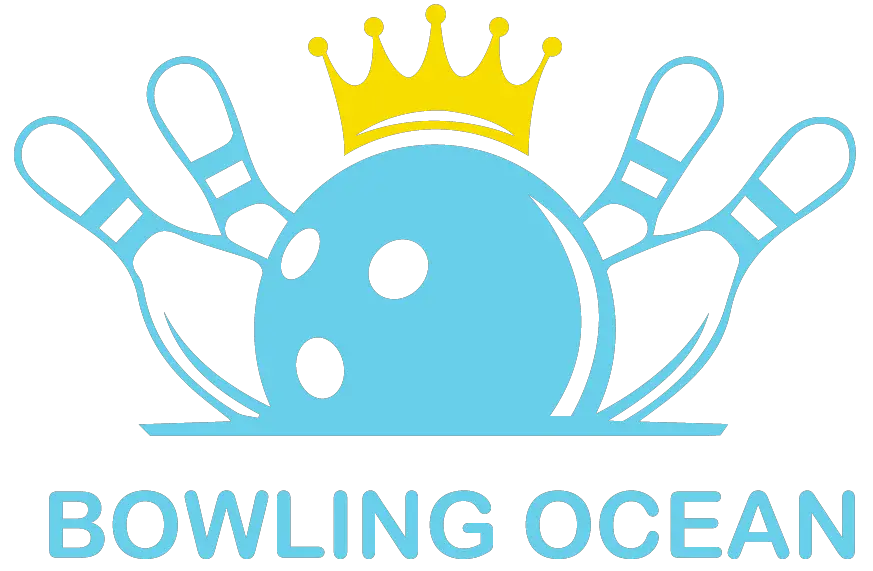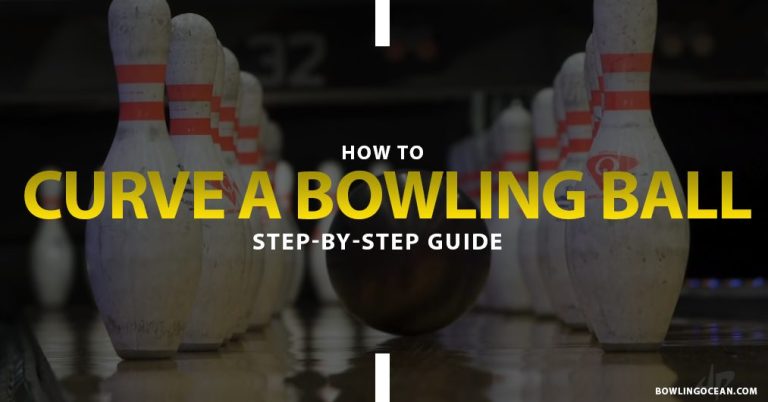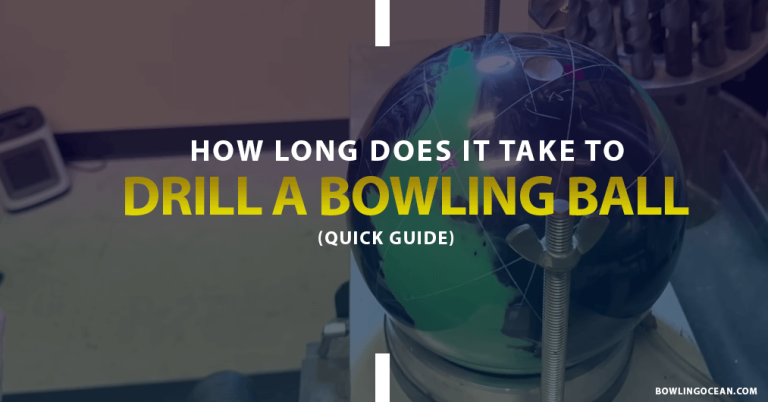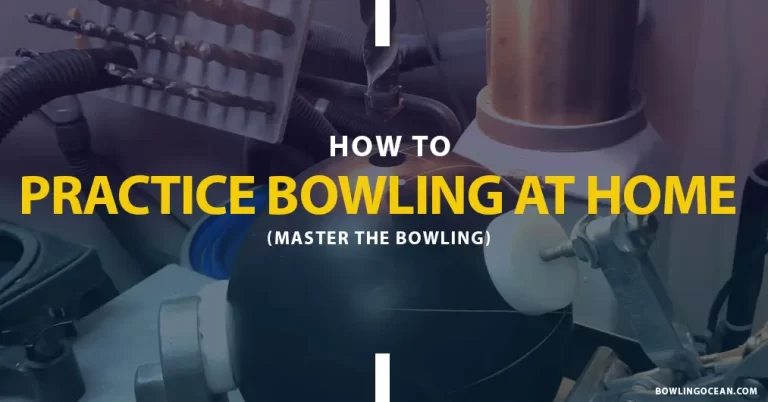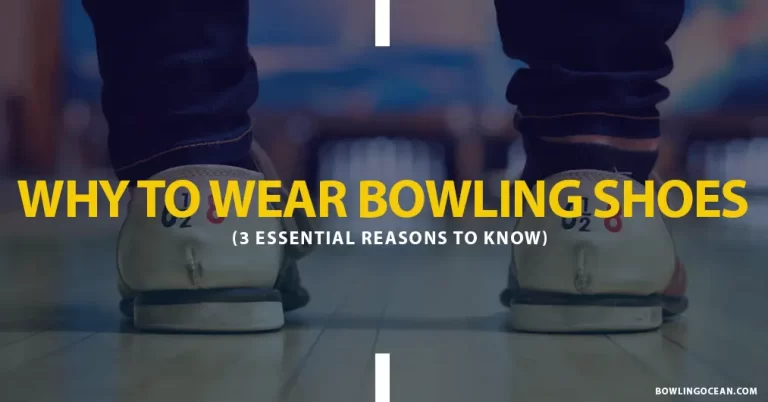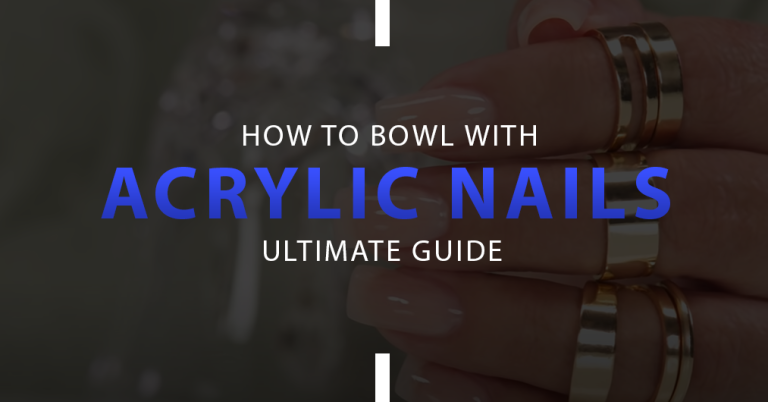Types Of Bowling Balls – How to Choose Right One?
When it comes to bowling, the first thing where you spend the utmost of your budget is a bowling ball but how do you know what kind of ball should I select?
Selecting the right bowling ball makes a significant impact and improves your overall performance, accuracy, and consistency in bowling. During choosing the bowling ball, it’s essential to consider the various conditions including lane condition, playing style, and skill level otherwise you will end up with the wrong type of ball that will decrease your efficiency, overall reaction, and even injury.
There are different types of bowling balls available and you may be wondering which one to purchase if you’re a beginner or just want to try an intermediate bowling ball.
Once you recognize all these types of bowling balls, you will be confident enough to pick the best ball. All you need to do is go through the entire guide for a better understanding.
In this guide, we will cover the overall construction of bowling balls including coverstock material and weight blocks that collaborate to have an impact on the game.
Construction Of Bowling Ball:

The entire concept behind bowling ball construction just consists of two parts: the coverstock and the weight block.
The coverstock is the outer part of the bowling ball that interacts with the bowling lane and has a significant role in bowling performance whereas the weight block is the inner piece of the bowling ball that defines the distribution of the weight and overall rolling motion on the lane.
There are different types of both coverstock and weight blocks that differentiate one bowling ball from others.
There are four types of coverstock material used in today’s bowling construction are follows:
- Plastic/Polyester: Designed for straight shots or less hook potential used by beginner bowlers.
- Urethane: One of the popular coverstock after plastic that creates medium to high hook potential with excellent backend action.
- Reactive resin: Great backend reaction with hook potential used by advanced bowlers.
- particle(Proactive): This coverstock uses various particles of different materials including resin, glass, and ceramic mixed to deliver higher hook potential.
The inner part of the bowling ball called the weight block is also divided into 2 types of blocks are followed:
- Symmetrical core: This type of core has an even distribution or equally spread weight blocks preferred for a smoother motion for straight shots.
- Asymmetrical core: Recommended for advanced bowlers looking for a decent reaction and higher hook potential. The weight blocks of asymmetrical core bowling balls are unevenly distributed.
History of bowling ball coverstocks
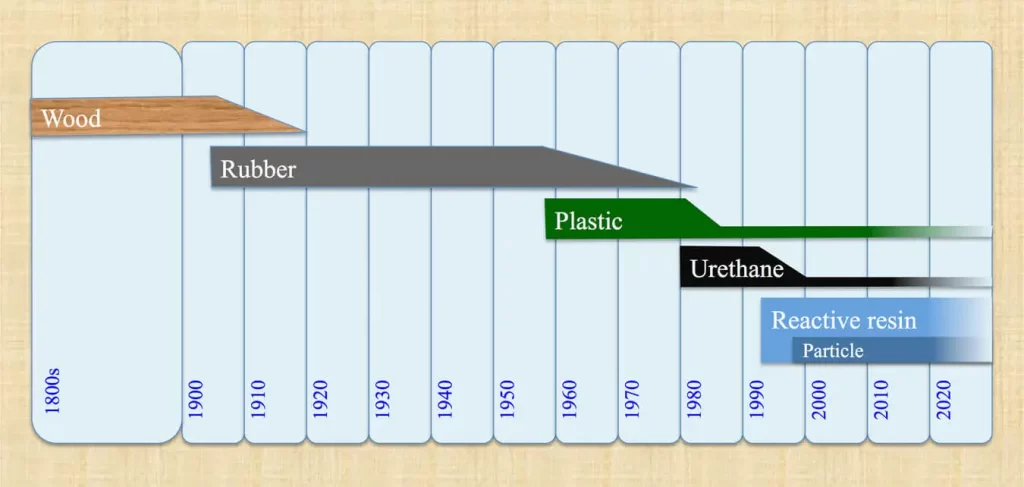
The story of bowling ball coverstocks is about how materials and technology have changed over time, affecting how bowling balls work on the lanes. Let’s explore this history:
- Wood Era (18th century – early 19th century): In the earliest days of bowling, people used to make bowling balls from wood, like lignum vitae. These wooden balls were basic and not as fancy as the bowling balls we have today. They didn’t have the special outer features that modern bowling balls do.
- Rubber Era (Pre-1950s): In the past, bowling balls were crafted from solid rubber. These balls were quite smooth and didn’t have the ability to curve much. To make the ball move the way they wanted, players had to depend a lot on their skill and how they threw it.
- Plastic Era (1950s-1970s): In the 1950s, the game of bowling saw a big change with the arrival of polyester and plastic coverstocks for balls. These new materials made a notable difference. Plastic balls had a more consistent and manageable way of moving, which made them well-liked by bowlers. Nevertheless, they still couldn’t create the strong curving effect known as “hook.”
- Urethane Era (1970s-1980s): During the 1970s, a new development occurred in bowling. Urethane coverstocks came onto the scene. These balls were better than plastic ones when it came to creating hook. They had a softer surface, which increased the friction with the lane and allowed for more curving action.
- Reactive Resin Era (1990s-2000s): In the 1990s, there was a major change in bowling thanks to reactive resin coverstocks. These covers had special things added to them that made them more porous, helping them hold onto the lane better. Because of this, these balls could create a lot more hook and make sharper turns as they moved. This was a big advancement in the game.
- Particle Coverstock Era (1990s-early 2000s): During the time when reactive resin balls were widely used, there was another type called particle coverstocks that became popular. These covers had tiny particles in them, which made them even better at creating friction and hooking. However, because these balls were causing a bit too much wear and tear on the lanes, their use was eventually limited.
- Hybrid Coverstocks (2000s-present): At that point, hybrid coverstocks came into play. These covers combined features from both reactive resin and solid coverstocks. This mix helped find a good balance between getting a good grip on the lane and being able to predict how the ball would move.
- Nanotechnology and Advanced Materials (2000s-present): In the more recent times, bowling has embraced nanotechnology and newer materials for making coverstocks. This has led to better durability, increased friction, and more precise control over how the ball moves. These advancements have brought even more sophistication to the game.
Over time, the improvements in coverstock technology have completely changed the way bowling is played. Bowlers now have a lot of choices to tailor their equipment based on how they play and the conditions of the lane. This progress in coverstocks has led to better scores, more intense competition, and a more exciting experience for those who love bowling.
4 Different types of Coverstock bowling balls
The coverstock affects the bowling ball’s performance including traction, durability, and hook potential. following are 4 different types of coverstock used in modern bowling.
1-Plastic/Polyester Coverstock:

Best Plastic Bowling Ball To Buy
The plastic coverstock also called polyester is made from the durable and hard plastic material commonly and basic coverstock bowling ball used by straight shots and entry-level bowlers
Due to its surface, this coverstock generates fewer fractions that make it deliver predictable and straight shots. It can be used as a spare bowling ball due to its predictable motion and is recommended for dry lane conditions because of its smooth surface.
Furthermore, it’s more affordable and comes in several colors and designs that are a cost-effective option for new and recreational bowlers.
Due to its low hook potential, it is not suitable for bowlers who would like to make aggressive hook shots, and it is also prone to cracking when exposed to high temperatures.
In the end, it’s the best option for the beginner who just wants to learn bowling and a budget-friendly bowling ball by spending a few bucks
2-Urethane Coverstock:
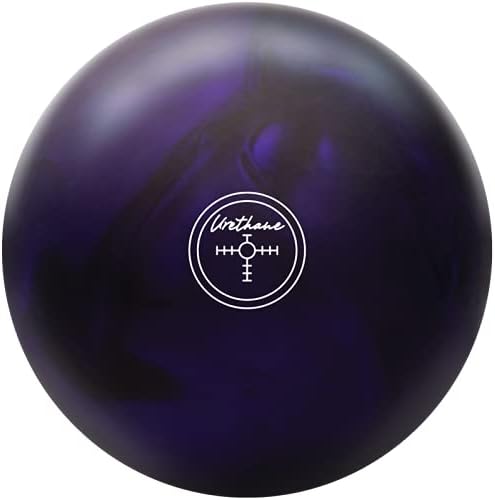
Best Urethane Bowling Ball To Buy
Urethane bowling ball is one of the most popular bowling balls among different bowlers from beginner to professional level due to its versatility and medium to high hook potential with reliable and consistent ball reaction.
The urethane bowling ball is adaptable on various bowling surfaces from dry to medium oil lane conditions. The urethane bowling ball is also well known due to its durability, consistency on the lane, and decent ball reaction to shots.
The urethane coverstock provides more durability and hook potential than the previous plastic coverstock. Conversely, there is a predictable and controllable motion delivered by the urethane bowling ball compared to other materials, such as reactive resin.
The urethane bowling ball does not deflect due to its increased fraction between the coverstock material and the bowling lane.
On the other hand, the bowling ball may be difficult to control and needs good skills in controlling the ball. The bowlers that are not experienced with hook shots may impact their accuracy and consistency.
Overall, the bowling ball is a good choice for bowlers who prefer to bowl on several lane conditions, the versatility of the ball, and great consistency.
3-Reactive Resin Coverstock:

Best Reactive Resin Bowling Ball To Buy
Compared to others, reactive resin provides more hook potential, increased fractional, and pin action, and is the heavy hitter in the list and a bit expensive.
Due to its hook potential, it’s one of the choices of professionals or those who want to improve their game. The ball rolls into the lane faster and provides a beautiful game-play experience.
The nature of the bowling ball is excellent for medium to heavy oil lanes. With pros, you need to take care also because it’s less durable as compared to others and may damage. It can be hard to control for beginners due to its fraction but you can override this on the sub-category of that ball in pearl reactive.
The reactive resin has three types and each of them has its own features.
- Solid reactive: is actually a reactive resin with a mixture of mica materials in it. The surface of the ball gives more rolling capability and supplies additional fractions on oily lanes.
- Pearl Reactive: This type is the same as solid but has a microscopic reactive pore on the surface. Have less fraction and hooking potential
- Hybrid Reactive: is actually a combination of both, solid and pearl. One part is formed of solid and the other is a pearl with a variety of colors. You can avail of this on all kinds of conditions as it consists of both.
4-Particle (Proactive) Coverstock:

Best Plastic Bowling Ball To Buy
The particle coverstock has particles on the surface including glass, resin, ceramic and other types of material that ultimately maximize the performance of the bowling ball on the lane.
The popularity of this coverstock significantly increases due to its higher hook potential and stronger backend reaction.
Compared to other coverstocks such as reactive resin and urethane Particle coverstock can be an ideal bowling ball for those bowlers who are looking for a bowling ball with higher hook potential and great motion from medium to heavy oil lanes.
However, there are a few cons of this coverstock. The added particles that are able to create extra fractions may cause wear out faster as compared to other coverstock which may reduce the performance of the bowling ball. Furthermore, the ball would be hard to control for non-skillful bowlers and you have good control on hook shots.
In the end, the particle bowling ball is a great add-up for those bowlers who are looking for higher hook potential and good strong and backend action.
Weight blocks:
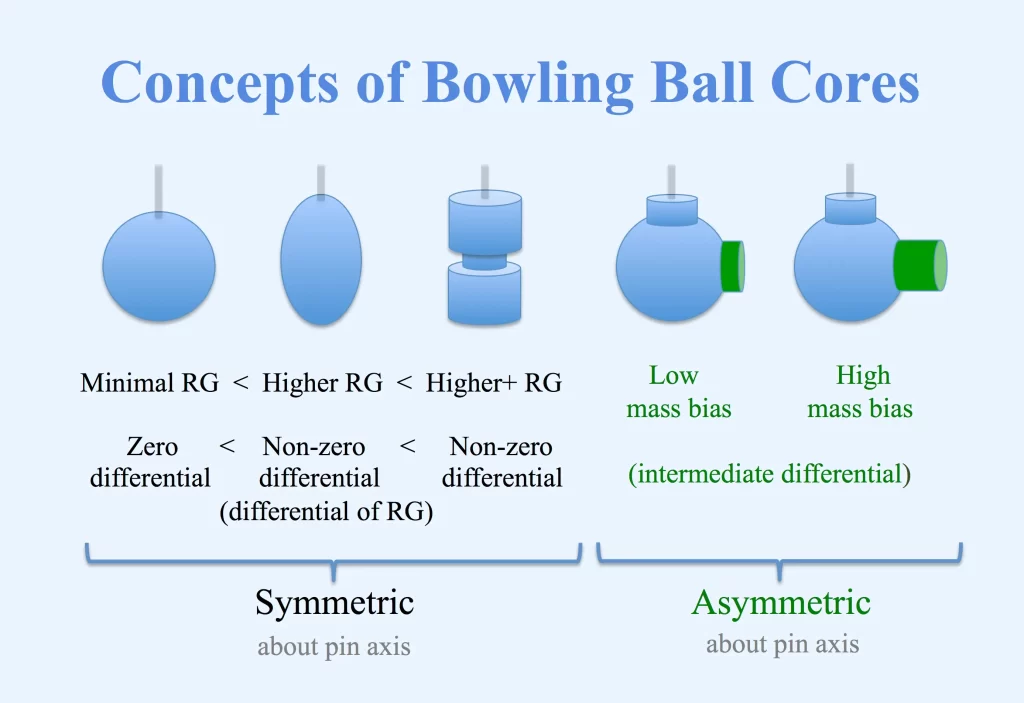
It is the weight block that enables the bowling ball to move predictably and in a balanced manner. Depending on the shape and design of the bowling ball, the weight can either be distributed evenly in the center or unevenly.
There are two types of weight blocks that are widely used in bowling balls symmetrical and asymmetrical weight blocks
Symmetrical weight block:
The symmetrical weight block is a type of weight block that has a uniform shape and evenly distributed mass at its center so the ball moves smoothly and efficiently.
There are two most common and popular shapes of weight blocks: pancakes and modern elliptical shapes. A cylindrical shape has rounded corners and uniform mass distribution, while an elliptical shape resembles a pancake but is more oven-like. As a result of its maximum differential and minimum RG, elliptical shapes have a slightly different ball motion than pancakes.
Overall, symmetrical weight blocks are known for their controlled ball motion, low differential, and low RG (radius of gyration). It’s a great option for straighter shots with controllable and smooth motion.
Asymmetrical weight block:
Asymmetrical is a type of weight block that has uneven weight distribution and various shapes. Compared to a symmetrical that is known for its regular shape and located at the center, an asymmetrical weight block is placed near the shell to deliver dynamic bowling ball motion.
The weight block distribution and irregular shape deliver dynamic and higher hook potential to the bowling ball. It’s a great choice for bowlers who are looking for angular and more curve the ball.
However, it can be difficult to handle the bowling ball, especially for beginner and non-skillful bowlers that have an idea of how to hook a bowling ball.
How to choose a bowling ball
A bowling ball is a vital piece of equipment in bowling that matters a lot in your overall performance and choosing the right bowling ball can make a big difference.
To buy the bowling ball that matches your requirements depends on several factors which need to be followed.
- Skill level: Whether you prefer straight or hook shots largely depends on the type of bowling ball you use. Selecting a bowling ball according to your preferences is made easier when you understand the skill level and style of the ball.
- Lane condition: A specific type of bowling ball designed for a particular lane. Understand what type of bowling ball is recommended to play in the kind of lane condition whether it’s dry or oily lane e.g. reactive resin bowling ball may perform better on oily lanes.
- Weight: The weight of the bowling ball should be comfortable and not much heavy or not lightweight. Choose a weight that is easy to control and you can throw it several times without any strains on your arm. The basic rule of thumb is to choose a bowling ball weight that is approximately 10% of your body weight.
- Coverstock: The different types of coverstock, such as plastic, urethane, reactive resin, and particle, must be understood depending on your skill level. For example, plastic coverstock is recommended for beginners because it’s easy to control, while reactive resin requires advanced skills and is recommended for professionals.
- Weight block: The weight block of the bowling ball determines how it will roll on the lane. Symmetrical weight blocks deliver more predictable motion whereas asymmetrical weight blocks roll dynamically.
By putting these steps while choosing a bowling ball will make a greater impact on overall game performance.
Conclusion:
There are different types of bowling balls and it widely depends on the level of expertise in bowling. Each bowling ball has its own features, some are relatively more weight with extra hook potential and others are expensive.
The vast majority of available bowling balls are plastic that you will commonly see in every bowling club. These are comparatively lighter and easy to control and if you’re a beginner then this is the best option for your first shot.
FAQs:

William Martin is a passionate bowler who spends most of his weekends playing the sport. With years of intense experience under his belt, William decided to share his knowledge by creating BOWLING OCEAN. Join me on this journey to explore the world of bowling and discover the tips and tricks to becoming a pro.
